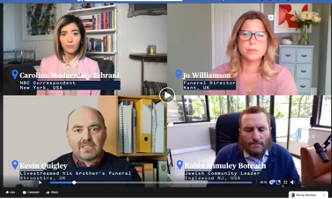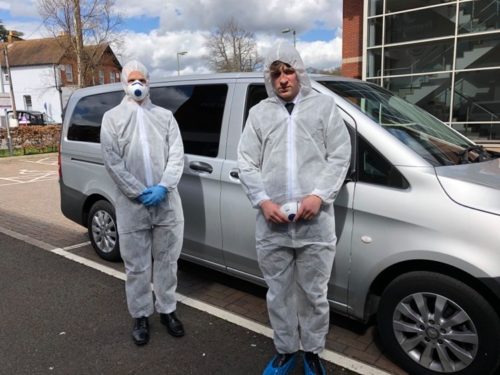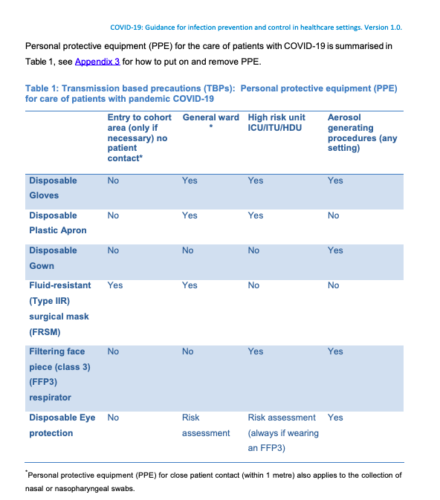It feels almost ridiculous to be asking readers of this blog to find the time to read and respond to the second set of working papers from the Competition and Markets Authority at this time of national crisis.
We’re fully aware that all sensible funeral directors are likely to be far too busy making certain that they and their staff are prepared to cope with the impact of Covid-19. (So far, there has been no official advice for the funeral sector other than the information we reported on in this blog post last week, but we understand that those who have been monitoring the situation in other countries are taking far higher level precautions).
We are, however, very conscious of the importance of this second consultation by the CMA, so for anyone who can possibly make time to send their observations to CMA team, we are sharing the questions below.
As with our other recent post on the CMA consultation, you can simply copy and paste the questions and then add your answers
Comments should be sent by email to funerals@cma.gov.uk by 19 March 2020.
The updated overview of key research and analysis can be found here.
Remedy options for regulating the price of funeral director services at the point of need
Working paper can be found here.
Table 1 (shown below) describes some possible elements which could be included in a benchmark package. We consider that these are the most commonly purchased funeral products and services.
Table 1
Suggested benchmark funeral package for consultation
Collection and transportation of the deceased (no time restrictions)
Storage of the deceased
Care of the deceased
Customer advice and support (may also be referred to as funeral director contact)
Legal and administrative services (including completing required documentation, liaison with third parties such as coroner)
Managing arrangements relating to burial, cremation, cemetery, church, ceremony, officiant
Date and time flexibility for funeral service
Arranging payment of third-party disbursements
Viewing of the deceased (suggested during the hours 8am – 6pm)
Dressing the deceased in their own clothes or gown
Provision of a ‘standard’ coffin
Provision of hearse and personnel
Choice of route for funeral profession (within defined radius)
One limousine
Embalming
We would welcome views on this proposed benchmark package, in particular:
(a) Are there are any products or services which are not currently included in the suggested benchmark package (Table 1) which should be included? What is the evidence to support this view?
(b) Are there are any products or services which have been included in the suggested benchmark package (Table 1) which should not be included? What is the evidence to support this view?
(c) Do you consider that there is evidence to suggest a lower or declining demand for any products or services in the suggested benchmark package, in particular we seek views on the use of limousine/s and embalming?
d) What is your view on including or excluding time-based restrictions on certain services, for example should collection, transportation of the deceased be available 24 hours a day, seven days a week or should viewing of the deceased at the place of storage/funeral director’s premises be limited to “office hours” such as 8am to 6pm. Also, should there be any restrictions on the route for the funeral procession?
(e) Are there any funeral director providers for whom the suggested “standard” benchmark funeral package (Table 1) would not be a suitable product/service to offer, for example a funeral director offering highly specialised or unique services?
(f) We are also considering whether an alternative approach, in particular a cap on average revenue per funeral, could be effective in addressing any AECs and customer detriment, whilst also addressing unintended market distortions such as the risk of a focal point for prices. Do you think this could be a better approach for price regulation?
We would welcome views regarding how might the Burial and Cremation (Scotland) Act 2016 interact with any price control regulation implemented by the CMA, or a new regulator and whether the price level of any price- controlled package should be set as one price across the UK.
We would welcome views on the proposals outlined in this working paper and any other comments on the proposed price control remedy. In particular we would welcome comments on the following questions:
Aims and approach of a price control remedy
(a) Do you agree that the introduction of a price control likely to be an effective solution to remedy any AECs and any resultant, or expected, detrimental effects on customers should they be found in this market investigation?
(b) Do you agree that the introduction of a price control remedy to be a necessary and proportionate solution (paragraph 19) to remedy any AECs and any resultant, or expected, detrimental effects on customers should they be found in this market investigation?
Price control design considerations
(c) Do you agree that all funeral directors should be subject to a price control remedy (paragraph 38)?
(d) Do you think there is a requirement to limit the application of any price control regulation to exempt certain providers and if so, what should the criteria for exemption be (paragraph 39)?
(e) Do you agree or disagree with the suggestion that a maximum price could be applied to a benchmark package of products and services (paragraph 59)?
(f) Do you agree with the suggested products and services within the proposed “standard” benchmark funeral package (paragraph 60)?
(g) Are there any funeral director providers for whom the suggested “standard” benchmark funeral package (paragraph 60(e)) would not be a suitable product/service to offer, for example a funeral director offering highly specialised or unique services?
(h) Do you consider that there is evidence to suggest a lower or declining demand for any products/services in the suggested benchmark package, in particular we seek views on the use of limousine/s and embalming (paragraph 47)?
(i) What is your view on including or excluding time-based restrictions on certain services, for example should collection, transportation of the deceased be available 24 hours a day, seven days a week or should viewing of the deceased at the place of storage/funeral director’s premises be limited to “office hours” such as 8am to 6pm. Also, should there be any restrictions on the route for the funeral procession (paragraph 60(d))?
(j) Do you consider that we should include a requirement for cost reflectivity for all disbursement costs within any price control regulation? If not, are there particular disbursement costs, for example cremation costs, which should be included (paragraph 57)?
(k) Alternatively, do you think that price control cap on average revenue per funeral, would be as effective in addressing any AECs and customer detriment, whilst also addressing unintended market distortions such as the risk of a focal point for prices (paragraph60(f))?
(l) Do you think the same approach to the design of a price control is required across the UK, or whether there should be any variation at a regional or devolved nation level (paragraph 69(a))?
(m) Do you think that one maximum price should be set for a benchmark package across the whole of the UK? Alternatively, what are your views on setting different regional or devolved nation prices (paragraph 69(b))?
(n) What are your views on the interaction of the Burial and Cremation (Scotland) Act 2016 with the proposal of price regulation in the UK (paragraph 74)?
Implementation, monitoring and enforcement
(o) What is your assessment of whether the option of setting a maximum price for a benchmark package of products/services (paragraph 60) is capable of effective;
(i) implementation?
(ii) monitoring?
(iii) enforcement?
(p) Do you think that compliance reporting requirements to the CMA or a regulator, should be the same for all funeral directors (paragraph94(b))?
(q) Do you have any views or suggestions on designing and implementing an effective communication strategy to ensure that consumers, funeral directors and relevant third parties understand their rights and responsibilities if price regulation is introduced in the funeral industry? In addition, how could we ensure that a benchmark package is sufficiently promoted and visible to consumers (paragraph 94(c))?
(r) What preparation would be required and how long do you think funeral directors might require in order to prepare for the implementation of any price control regulation?
(s) What would be the likely costs of implementation, monitoring and enforcement for funeral directors?
(t) Do you consider an initial duration of five to seven years is an appropriate period for the implementation of a price control remedy and achievement of its aims (paragraph 24)?
(u) Do you consider there to be other risks or options for mitigation which we have not considered (paragraphs 75-77)?
Please provide any other comments or questions.
Remedy options for regulating the price of crematoria services
Working paper can be found here.
We would welcome views on our current thinking that any price regulation in the form of a maximum price would apply to all crematoria operators in the same way.
We welcome views on the approach to defining the scope of products and services included in the benchmark package, in particular:
a) Are there are any products or services which are not currently included in the suggested benchmark package which should be included? What is the evidence to support this view?
b) Are there are any products or services which have been included in the suggested benchmark package which should not be included? What is the evidence to support this view?
c) What is your view on time-based restrictions relating to the benchmark package, for example the length of the chapel slot?
We welcome views on how the maximum price could be determined and reviewed, in particular:
a) Do you consider that using pricing information from the sector is a sensible approach for designing a price cap for crematoria? Do you think a rate of return approach would be more appropriate in this sector?
b) Do you have any views on the design variants we have outlined above (for example, whether the price level of any price regulated package should be set as one price across the UK, whether we should make allowances for certain higher cost areas such as London or whether any cost base should be assessed on a crematoria by crematoria basis or otherwise)?
c) Do you have any suggestions as to the criteria we should use to set the benchmark for the initial level of the price cap?
d) Do you have any views on how the Burial and Cremation (Scotland) Act 2016 should interact with any price regulation implemented by the CMA, or a new regulator?
We are also interested in responses to the following questions relating to implementation, monitoring and enforcement of the price control:
h) What is your assessment of whether the option of setting a maximum price for a benchmark package of products/services (paragraph 49) is capable of effective;
- implementation?
- monitoring?
- enforcement?
i) Do you think that compliance reporting requirements to the CMA or a regulator, should be the same for all crematoria?
j) Do you have any views or suggestions on designing and implementing an effective communication strategy to ensure that consumers, crematoria and relevant third parties understand their rights and responsibilities if price regulation is introduced? In addition, how could we ensure that a benchmark package is sufficiently promoted and visible to consumers (paragraph 105.b)?
k) What preparation would be required and how long do you think crematoria might require to prepare for the implementation of any price control regulation?
l) What would be the likely costs of implementation, monitoring and enforcement for crematoria?
m) Do you consider an initial duration of 5 to 7 years is an appropriate period for the implementation of a price control remedy and achievement of its aims (paragraph 108)?
n) Do you consider there to be other risks or options for mitigation which we have not considered (paragraphs 83-86)?
Please provide any other comments or questions.
Local authority tendering remedy proposal
Working paper can be found here.
We would welcome views on the proposals outlined in this working paper and any other comments on a proposed LA tendering remedy. In particular, we would welcome comments on the following questions.
LA tendering as a remedy option
(a) To what extent do respondents think that wider introduction of tendered LA low-cost funeral schemes, intended as a response to problems identified on the demand side of the market would be: (a) effective; (b) proportionate. Please answer with respect to each of the implementation options available, that is:
(i) a CMA Order applicable to all LAs;
(ii) a CMA recommendation to LAs;
(iii) a CMA recommendation to central government(s) that it/they should create a statutory responsibility on LAs.
(b) How should the specification of the funeral product to be provided under a LA scheme be determined?
(i) Should the focus be on delivering a competitive negotiated price for a ‘standard’ funeral package, or addressing funeral poverty through ensuring availability of a low-cost respectful funeral option.
(ii) How much scope, if any, should there be for variations between LAs?
(c) What might be potential unintended consequences of wider LA tendering for low cost residents’ funerals?
(d) What are the current barriers to LAs establishing tendered low cost funeral schemes (eg available resources, other priorities, not regarded as a LA responsibility, etc)? How might they be overcome?
(e) What are the barriers to funeral director participation in LA tenders for resident schemes? How might they be overcome?
(f) What are the barriers to take-up of LA resident schemes by bereaved families? How might they be overcome? What types of bereaved people/families would be most likely to use such schemes?
(g) What impact have existing LA schemes had on wider pricing for funerals in their respective local areas?
(h) What should be the CMA’s priorities for further analysis or evidence gathering on existing schemes?
LA tendering as basis for price benchmarks
(i) Do respondents think that the outcomes of current and future LA tendering exercises for provision of resident funeral schemes could provide useful data points for benchmarks to feed into price controls?
Other comments
(j) Please provide any other relevant comments or observations on these proposals.



